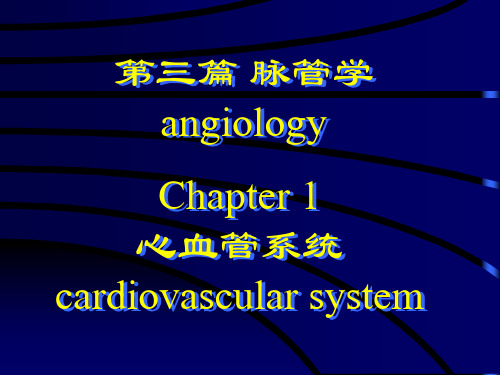02.循环解剖anatomy of cardiovascular system
- 格式:ppt
- 大小:71.08 MB
- 文档页数:37

医科专业英语1. anatomy解剖学2. physiology生理学3. epithelial tissue上皮组织4. connective tissue结缔组织5. muscular tissue肌肉组织6. nervous tissue神经组织7. the integumentary system体被系统8. the skeletal system骨骼系统9. the muscular system肌肉系统10. the lymphatic system淋巴系统11. the respiratory system呼吸系统12. the digestive system消化系统13. the nervous system神经系统14. the endocrine system内分泌系统15. the cardiovascular system心血管系统16. the urinary system泌尿系统17. the reproductive system生殖系统18. the cranial cavity颅腔19. the spinal cavity脊髓腔20. the thoracic cavity胸腔21. the abdominopelvic cavity盆腹腔22. homeostasis内环境稳定23. metabolism新陈代谢1.morphology 形态学, 生态学2.etiology 病因学, 病原学3.pathogenesis 发病学, 发病机理4.intrauterine 子宫内的5.endoscopy 内窥镜检查6.biopsy 活组织检查7.pathogen病菌; 病原体8.inflammatory diseases炎性疾病9.degenerative diseases变性性疾病, 退行性疾病10.metabolic diseases代谢性疾病11.congenital and hereditary diseases先天性和遗传性疾病12.neoplastic diseases肿瘤性疾病13.prognosis预后14.clinical history临床史15.specific treatment特异疗法, 特效(药)疗法16.symptomatic treatment症状疗法, 对症治疗17.chromosome染色体18.noninvasive procedures无创检查19.recessive gene隐性基因20.dominant gene显性基因anic disease器质性疾病22.electrocardiogram 心电图1.carbohydrate 碳水化合物2.esophagus 食管3.duodenum十二指肠4.pepsin 胃蛋白酶5.peristalsis蠕动6.cardiac / pyloric sphincter贲门/幽门括约肌7.gastrointestinal track胃肠道8.hydrochloric acid盐酸9.amino acid氨基酸10.glycerol甘油; 丙三醇11.gallbladder胆囊12.ileocecal valve回盲瓣13.salivary glands 涎腺,唾液腺14.hard/soft palate硬/软腭15.epiglottis 会厌mon bile duct 胆总管17.rectum直肠18.villus绒毛19.digestive enzyme消化酶20.taste bud味蕾21.appendix 阑尾22.ascending /descending colon 升/降结肠23.sigmoid colon 乙状结肠24.bowel movement 大便25.chyme 食糜1.respiratory tract呼吸道2.pharynx咽3.trachea气管4.bronchiole细支气管5.epithelial cell上皮细胞6.macrophage巨噬细胞7.oxygen氧气8.carbon dioxide二氧化碳9.mucous membrane粘膜10. nasal passage鼻道11. allergy变态反应(症), 过敏症12. swallowing reflex吞咽反射13. lymphatic tissue淋巴组织14. ciliated cell纤毛细胞15. inhalation吸入,吸气16. exhalation呼出,呼气17. nostril鼻孔18. cartilage软骨19. larynx喉20. alveolus肺泡21. tonsil 扁桃体22. irreversible damage 不可逆性损伤1. cardiovascular system心血管系统2. circulatory system循环系统3. plasma血浆4. erythrocyte红细胞5. leukocyte白细胞6. platelet count血小板计数7. megakaryocyte巨核细胞8. hematocrit血细胞比容9. hemoglobin血红蛋白10. diffuse扩散,弥漫11. granulocyte粒细胞12. osmotic pressure渗透压13. phagocytosis吞噬作用14. interferon干扰素15. systemic circulation体循环16. pulmonary circulation肺循环17. deoxygenated blood去氧血18. tricuspid valve三尖瓣19. pulmonic valve肺动脉瓣20. aortic valve主动脉瓣21. tachycardia心动过速22. bradycardia心动过缓23. systole心缩期24. diastole心舒期1. atrium心房2. ventricle心室3. mitral / bicuspid valve二尖瓣4. semilunar valve半月瓣5. endocardium心内膜6. myocardium心肌7. epicardium心外膜8. pericardium心包(膜)9. pulmonary trunk肺动脉干10. stethoscope听诊器11. murmur (心脏)杂音,12. pacemaker cell P细胞(起搏细胞)13. sinus /sinoatrial node窦房结14. atrioventricular node房室结15. aorta主动脉16. common carotid artery颈总动脉17. artery动脉18. capillary毛细血管19. superior / inferior vena cava上腔静脉/下腔静脉。



关于介绍心脏循环系统的英语作文Title: Introduction to the Cardiovascular SystemThe cardiovascular system, also known as the circulatory system, is responsible for the transportation of oxygen, nutrients, hormones, and other substances throughout the body. It plays a vital role in maintaining homeostasis and supporting the overall functioning of the body. In this article, we will explore the structure and functions of the cardiovascular system in detail.Structure of the Cardiovascular SystemThe cardiovascular system consists of the heart, blood vessels, and blood. The heart is a muscular organ located in the chest cavity, slightly to the left of the midline. It is divided into four chambers: two upper chambers called atria and two lower chambers called ventricles. The heart acts as a pump that propels blood through the blood vessels to all parts of the body.The blood vessels are divided into three types: arteries, veins, and capillaries. Arteries carry oxygen-rich blood away from the heart to the body's tissues and organs. Veins carry oxygen-poor blood back to the heart. Capillaries are small, thin-walled vessels that connect arteries and veins, allowing for the exchange ofoxygen, nutrients, and waste products between the blood and tissues.Functions of the Cardiovascular SystemThe main functions of the cardiovascular system include:1. Transportation of oxygen and nutrients: The heart pumps oxygen-rich blood to the body's tissues and organs, providing them with the necessary oxygen and nutrients for energy production and cell function.2. Removal of waste products: The cardiovascular system also helps in removing waste products, such as carbon dioxide and metabolic waste, from the tissues and organs to be eliminated from the body.3. Regulation of body temperature: Blood flow helps regulate body temperature by redistributing heat from the core to the skin surface, where it can be dissipated.4. Protection from pathogens: The cardiovascular system plays a role in the immune response by transporting white blood cells and antibodies to fight off infections and foreign invaders.5. Maintenance of homeostasis: The cardiovascular system helps maintain the balance of fluids, electrolytes, and pH levels in the body, essential for optimal functioning of cells and tissues.Path of Blood CirculationThe circulation of blood in the cardiovascular system follows a specific path:1. Deoxygenated blood from the body enters the right atrium of the heart through the superior and inferior vena cava.2. The right atrium contracts, forcing the blood to pass through the tricuspid valve into the right ventricle.3. The right ventricle contracts, pumping the blood through the pulmonary valve and into the pulmonary artery.4. The pulmonary artery carries the deoxygenated blood to the lungs, where it picks up oxygen and releases carbon dioxide.5. Oxygenated blood returns to the heart through the pulmonary veins, entering the left atrium.6. The left atrium contracts, forcing the blood through the mitral valve into the left ventricle.7. The left ventricle contracts, pumping the oxygenated blood through the aortic valve and into the aorta.8. The aorta distributes the oxygenated blood to the body's tissues and organs through a network of arteries and capillaries.ConclusionThe cardiovascular system is a complex network of organs and vessels that work together to ensure the proper circulation of blood and essential nutrients to all parts of the body. Understanding the structure and functions of the cardiovascular system is crucial for maintaining overall health and well-being. By taking care of our heart and blood vessels through a healthy lifestyle, regular exercise, and proper nutrition, we can support the optimal functioning of the cardiovascular system and promote longevity and vitality.。


人体解剖学英汉名词对照表注:用星号(*)标注的名词为最常用的词汇,必须熟记掌握。
一、总论(一)解剖学分类(Classification of Anatomy)anatomy 解剖学human anatomy, anthropotomy 人类解剖学systematic anatomy 系统解剖学regional (topographic)anatomy, topology 局部解剖学gross (macroscopic)anatomy 大体解剖学,巨视解剖学microscopic anatomy 显微解剖学macro—microscopic anatomy 巨—微解剖学sectional anatomy 断面解剖学pathological (morbid) anatomy 病理解剖学neuroanatomy 神经解剖学chemical neuroanatomy 化学解剖学developmental anatomy 发生(或发育)histologic anatomy 组织解剖学histology 组织学embryology 胚胎学anthropology 人类学(二)一般解剖学术语(General Anatomical Terms)dissection,dissect (v.) 解剖,解剖标本normality,normal (a.) 正常abnormality , abnormal 异常variation 变异deformity,malformation 畸形specimen 标本model 模型(三)方位术语(Positional Terms)1。
anatomical position 解剖学姿势2。
方位术语(terms of direction)superior,upper 上inferior, lower 下anterior 前侧posterior 后侧ventral (dorsal)腹(背)侧medial (lateral)内(外)侧intermediate 中间internal, interior,inner, inside 内external, exterior,outer,outside 外superficial 浅deep,profound 深proximal (distal)近(远)侧ulnar (radial)尺(桡)侧tibial (fibular) 胫(腓)侧palmar 掌侧plantar 足底left 左right 右middle 中median 正中3。
宠物解剖的名词解释引言:宠物是人类生活中的重要伙伴,陪伴我们度过独自的时光,给予我们无条件的爱与关怀。
然而,要更好地照顾和理解宠物的健康,对于宠物解剖学的了解是不可或缺的。
本文将通过对宠物解剖学中一些关键名词的解释,帮助读者更好地理解宠物的身体结构和功能。
1. 解剖学 (Anatomy)解剖学是研究生物体内部结构的科学领域,通过对不同生物体进行解剖,可以深入研究它们的器官、组织和细胞的结构、形态和功能。
对于宠物解剖学而言,解剖学研究了狗、猫等宠物的体内结构,为兽医学提供了基本的理论依据。
2. 骨骼系统 (Skeletal System)宠物的骨骼系统是由骨头、关节和韧带组成的。
骨头是身体支撑和保护内脏器官的骨架,而关节则使骨头能够相对运动。
韧带则连接骨头与骨头,以及骨头与肌肉,起到稳定关节和保护连接处的作用。
通过了解宠物骨骼系统的结构和功能,我们可以更好地理解宠物的运动和姿势。
3. 心血管系统 (Cardiovascular System)宠物的心血管系统是由心脏、血管和血液组成的。
心脏是宠物体内的泵,通过收缩和舒张来泵送血液到全身各个器官和组织,供应氧气和养分。
血管则将血液输送到全身,包括动脉和静脉。
宠物的心血管系统起着重要的循环作用,维持着身体的正常功能。
4. 消化系统 (Digestive System)宠物的消化系统负责将食物分解为营养物质,以供给身体所需的能量和养分。
消化系统包括口腔、食管、胃、肠道和相关器官。
在消化过程中,食物被分解成小分子,以便身体吸收。
了解宠物消化系统的结构和功能,可以帮助我们更好地选择适合宠物的饮食和保持宠物的健康。
5. 呼吸系统 (Respiratory System)宠物的呼吸系统负责供应氧气并排出二氧化碳等废气。
呼吸系统包括鼻腔、气管、支气管和肺部。
当宠物呼吸时,空气进入鼻腔,经过气管和支气管进入到肺部,氧气被吸收,而废气则通过呼出被排出体外。
了解呼吸系统的结构和功能,有助于我们更好地照顾宠物的呼吸健康。